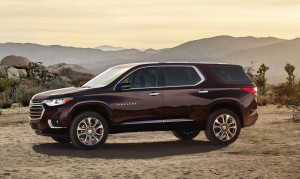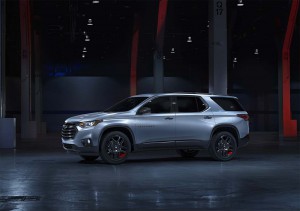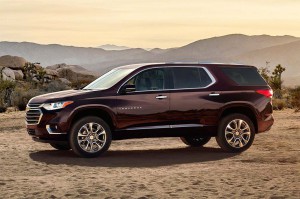
The Chevrolet Traverse tied with its siblings, the GMC Acadia and Buick Enclave, as the most American vehicle on the market in a recent study.
When Chevrolet unveiled the all-new 2018 Traverse earlier this year, it revealed a three-row ute that is larger in just about every dimension. The question is whether it will grow larger in the column that matters most to Chevy’s bookkeepers.
Compared to the midsize SUV segments dominant nameplates, like the Toyota Highlander and Ford Explorer, the Traverse has been a relative afterthought. But Chevy is hoping that the significant upgrades it’s making will sharply boost demand in the coming year, especially at a time when utility vehicles continue to gain momentum even as the overall U.S. automotive market slips into the doldrums after three years of record sales.
Officials with General Motors are so confident about the new model, in fact, that they’re studying ways to squeeze more utes out of the Lansing, Michigan plant Traverse shares with midsize offerings from the Buick and GMC brands, the brand’s marketing chief told TheDetroitBureau.com during a briefing on the all-new 2018 model.
“We’re onto something,” marketing chief Steve Majoros said. Referring to initial consumer response to the 2018 Chevrolet Traverse. Initial data has shown a positive response to the ute’s design and features, as well as to the higher-line versions that will be introduced this coming year, such as the Traverse High Country.
The outgoing model was targeted largely on the low to midrange SUV buyer, the typical 2017 Traverse carrying an MSRP of just under $39,000 compared to the midsize segment average of $41,285. Chevy hopes to boost that substantially for 2018, in part, by adding more features and high-line models. The High Country, which will come with virtually every possible feature in the Traverse catalogue, will go for an MSRP of $53,800.
Chevy isn’t alone in pushing up-market. Ford, for example has added a series of ever more expensive trim levels for its SUV and pickups in recent years.
By touching on a broader range of midsize SUV buyers, Chevy believes it can boost sales from last year’s 85,000. Even as the old Traverse has headed for the end of its run, demand has remained strong, but the nameplate still holds just 7.0% of the midsize SUV segment, compared 12.0% for Explorer, and 13.6% for both the Jeep Grand Cherokee and Toyota Highlander.
(Chevy Traverse named “Most American” vehicle in new study. Click Here to see why.)
“We’re going to attack in segments of the market where we haven’t been competitive,” said Majoros.
While Chevy may see some opportunities to boost sales and build market share, however, it currently can go only so far with the new Traverse. That’s because the Lansing Delta Township Assembly Plant, near Michigan’s capital, where it’s built, is already operating at capacity. Along with the 85,000 Traverse SUVs it produced last year, the factory also rolled out 65,000 utes for GMC and another 25,000 for Buick.
“We’re looking at that capacity,” Majoros said in an interview, though he quickly stressed “We haven’t made a decision. We’re not rushing to judgement.”
Before making a move to expand the Delta plant’s capacity – which could cost hundreds of millions of dollars – “We want to be sure the market is sustainable.” That’s a significant question at a time when overall U.S. new vehicle sales have been tumbling faster than anticipated. So far, compact and midsize SUVs and CUVs have defied gravity, but it’s far from certain they can continue to do that indefinitely.
(U.S. auto sales spiral downward in July. Click Here for the latest.)
Some industry planners think the utility vehicle boom is far from over, however. Ford Executive Vice President Joe Hinrichs recently predicted that the SUV share of the overall market could rise anywhere from another five to 10 percentage points, to as much as half of all new U.S. vehicle sales.
If that proves accurate, Chevy might need to do more than just boost capacity at the Lansing, Michigan plant. Of course, it could have other options. It has eliminated six production shifts at various passenger car plants since just last November, and it is studying whether to drop as many as six of its North American passenger car models, including the Chevrolet Impala and Volt. That could free up space for a significantly larger bump in SUV production.
Majoros sidestepped that topic, something for a higher pay grade to decide. But with competitors like Fiat Chrysler, Ford and Toyota rejiggering their production plans to take better advantage of the SUV boom, GM – and Chevy, in particular – may need to make similar moves in the near future.
(Chevy hits the Redline. Click Here for more on the new, sporty edition of the 2018 Traverse.)


